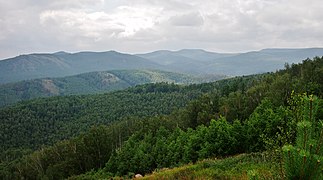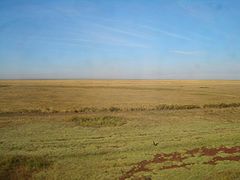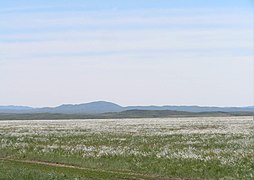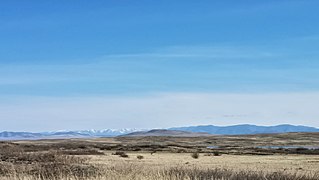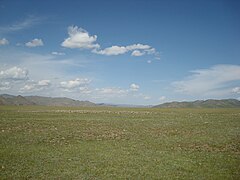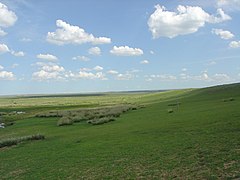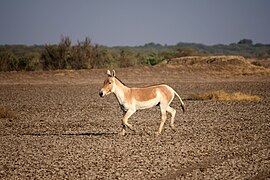Eurasian Steppe

TheEurasian Steppe,also called theGreat SteppeorThe Steppes,is the vaststeppeecoregionofEurasiain thetemperate grasslands, savannas and shrublandsbiome.It stretches throughHungary,Bulgaria,Romania,Moldova,Ukraine,southern Russia,Kazakhstan,Xinjiang,MongoliaandManchuria,with one majorexclave,thePannonian steppe,located mostly inHungary.[1]
Since thePaleolithic age,theSteppe Routehas been the main overland route betweenEurope,Western Asia,Central Asia,East AsiaandSouth Asiaeconomically, politically, and culturally. The Steppe route is a predecessor not only of theSilk Road,which developed duringantiquityand theMiddle Ages,but also of theEurasian Land Bridgein the modern era. It has been home tonomadic empiresand many largetribalconfederationsand ancient states throughout history, such as theXiongnu,Scythia,Cimmeria,Sarmatia,Hunnic Empire,Sogdia,Xianbei,Mongol EmpireandGöktürk Khaganate.
Geography[edit]
Divisions[edit]
The Eurasian Steppe extends for 8,000 kilometres (5,000 miles) from near the mouth of theDanubein Romania to the western edge ofManchuria.It is bounded on the north by the forests ofEuropean RussiaandAsian Russia or Siberia.There is no clear southern boundary although the land becomes increasingly dry as one moves south. The steppe narrows at two points, dividing it into three major parts.
Pannonian Steppe (exclave)[edit]
ThePannonian Steppeis a westernexclaveof the Eurasian Steppe, separated from the main steppe by theCarpathian Mountains.It is found in modern-dayAustria,Hungary,Romania,SerbiaandSlovakia.
-
ThePannonian steppein Seewinkel,Austria
Pontic–Caspian Steppe (Western Steppe)[edit]
ThePontic–Caspian Steppeis the mainEuropeanend of the Eurasian Steppe and begins near the mouth of theDanube,stretching northeast almost toKazanand then southeast to the southern tip of theUral Mountains.Its northern edge was a broad band offorest steppewhich has now been obliterated by the conversion of the whole area to agricultural land. In the southeast the Black Sea–Caspian Steppe extends between theBlack SeaandCaspian Seato theCaucasus Mountains.In the west, theGreat Hungarian Plainis an island of steppe separated from the main steppe by the mountains ofTransylvania.On the north shore of the Black Sea, theCrimean Peninsulahas some interior steppe and ports on the south coast which link the steppe to the civilizations of the Mediterranean basin.
-
ThePontic–Caspian steppenear Krynychne,Ukraine.
Ural–Caspian Narrowing[edit]
The steppe narrows around the southern end of theUral Mountains,about 650 km (400 mi) northeast of theCaspian Sea,forming the Ural-Caspian Narrowing, that joins the Pontic-Caspian Steppe in Europe with theKazakh SteppeinCentral Asia.
-
WoodedUral MountainsofBeloretsky District,Russia
-
Bashkiriya National Park,southern end of the Ural Mountains, Russia
-
Bashkiriya National Park, Ural Mountains, Russia
Kazakh Steppe (Central Steppe)[edit]
TheKazakh Steppemakes up most of the Eurasian Steppe in Central Asia. It extends from theUralstoDzungaria.To the south, it grades off into semi-desert and desert which is interrupted by two great rivers, theAmu Darya(Oxus) andSyr Darya(Jaxartes), which flow northwest into theAral Seaand provide irrigation for agriculture. In the southeast is the densely populatedFergana Valleyand west of it the great oasis cities ofTashkent,SamarkandandBukharaalong theZeravshan River.The southern area has a complex history (seeCentral AsiaandGreater Iran), while in the north, the Kazakh Steppe proper was relatively isolated from the main currents ofwritten history.
-
The steppe inAkmola Region,Kazakhstan.
-
The steppes inAkmola Province,Kazakhstan.
-
TheKazakh Steppein the early spring.
Dzungarian Narrowing[edit]
On the east side of the formerSino-Soviet border,mountains extend north almost to the forest zone separating the Dzungarian Narrowing from the Central Asian steppe, leaving only limited grassland inDzungaria.This discontinuous section of the Eurasian steppe connects the great steppes ofCentral AsiaandEast Asia.
The east-westTian Shan Mountainsdivide the steppe into Dzungaria in the north and the Tarim Basin to the south.Dzungariais bounded by theTarbagatai Mountainson the west and theMongolianAltai Mountainson the east, neither of which is a significant barrier. Dzungaria has good grassland around the edges and a central desert. It often behaved as a westward extension of Mongolia and connected Mongolia to the Kazakh Steppe. To the north of Dzungaria are mountains and the Siberian forest. To the south and west of Dzungaria, and separated from it by theTian Shanmountains, is an area about twice the size of Dzungaria, the ovalTarim Basin.The Tarim Basin's arid conditions make it unsuitable for sustaining a nomadic population. However, along its periphery, rivers descend from the mountains, creating a circle of cities that thrived on irrigation agriculture and engaged in east-west trade. The Tarim Basin formed an island of near civilization in the center of the steppe. TheNorthern Silk Roadwent along the north and south sides of the Tarim Basin and then crossed the mountains west to theFergana Valley.At the west end of the basin thePamir Mountainsconnect the Tian Shan Mountains to theHimalayas.To the south, theKunlun Mountainsseparate the Tarim Basin from the thinly peopledTibetan Plateau.
-
Dus-Khol lake,Tuva Republic,Russia.
-
The grassland inTuva Republic,Russia.
Mongolian-Manchurian Steppe (Eastern Steppe)[edit]
TheMongolian-Manchurian Steppeis the main part of the Eurasian Steppe in East Asia. It covers large parts ofMongoliaand the Chinese province ofInner Mongolia.The two are separated by a relatively dry area marked by theGobi Desert.South of the Mongol Steppe is the high and thinly peopledTibetan Plateau.The northern edge of the plateau is theGansuorHexi Corridor,a belt of moderately dense population that connectsChina properwith theTarim Basin.TheHexi Corridorwas the main route of theSilk Road.In the southeast the Silk Road led over some hills to the east-flowingWei Rivervalley which led to theNorth China Plain.
South of the Khingan Mountains and north of theTaihang Mountains,the Mongolian-Manchurian steppe extends east into Manchuria as the Liao Xi steppe. In Manchuria, the steppe grades off into forest and mountains without reaching the Pacific. The central area of forest-steppe was inhabited by pastoral and agricultural peoples, while to the north and east was a thin population of hunting tribes of the Siberian type.
-
The Mongolian-Manchurian grassland in theKhövsgöl Province,Mongolia.
-
Grass steppe in theKhövsgöl Province,Mongolia.
-
Daursky Nature Reservein the southern part of the Zabaykalsky Krai in Siberia, Russia, close to the border with Mongolia.
-
The Mongolian-Manchurian grassland inInner Mongolia,China.
Fauna[edit]
Big mammals of the Eurasian steppe were thePrzewalski's horse,thesaiga antelope,theMongolian gazelle,thegoitered gazelle,thewild Bactrian cameland theonager.[2][3][4][5][6][7]Thegray wolf,corsac fox,Pallas's catand occasionally thebrown bearare predators roaming the steppe.[8][9][10][11]Smaller mammal species are theMongolian gerbil,thelittle souslikand thebobak marmot.[12][13][14]
Furthermore, the Eurasian steppe is home to a great variety of bird species. Threatened bird species living there are for example theimperial eagle,thelesser kestrel,thegreat bustard,thepale-back pigeonand thewhite-throated bushchat.[15]
The primary domesticated animals raised were sheep and goats with fewer cattle than one might expect.Camelswere used in the drier areas for transport as far west asAstrakhan.There were someyaksalong the edge ofTibet.The horse was used for transportation and warfare.The horse was first domesticatedon the Pontic–Caspian or Kazakh steppe sometime before 3000 BC, but it took a long time formounted archeryto develop and the process is not fully understood. Thestirrupdoes not seem to have been completely developed until 300 AD (seeStirrup,Saddle,Composite bow,Domestication of the horseand related articles).
Ecological processes[edit]
Parts of the Eurasian steppe experience an ecological regime shift in form ofwoody plant encroachment,such as the Black Sea-Kazakhstan steppe, the Tibetan Plateau steppe, and the Central Asian steppe. This process involves the gradual increase of shrubs at the expense of grasses.[16]
Ecoregions[edit]
TheWorld Wide Fund for Naturedivides the Eurasian steppe's temperategrasslands,savannasandshrublandsinto a number ofecoregions,distinguished by elevation, climate, rainfall, and other characteristics and home to distinct animal andplant communitiesand species and distincthabitatecosystems.
- Alai–Western Tian Shan steppe(Kazakhstan, Turkmenistan, Uzbekistan)
- Altai steppe and semi-desert(Kazakhstan)
- Baraba steppe(Russia)
- Daurian forest steppe(China, Mongolia, Russia)
- Emin Valley steppe(China, Kazakhstan)
- Kazakh forest steppe(Kazakhstan, Russia)
- Kazakh Steppe(Kazakhstan, Russia)
- Kazakh Uplands(Kazakhstan)
- Mongolian-Manchurian grassland(China, Mongolia, Russia)
- Pontic–Caspian steppe(Moldova, Romania, Russia, Ukraine)
- Sayan Intermontane steppe(Russia)
- Selenge–Orkhon forest steppe(Mongolia, Russia)
- South Siberian forest steppe(Russia)
- Tian Shan foothill arid steppe(China, Kazakhstan, Kyrgyzstan)
- Pannonian Steppe[17](Hungary, Romania, Serbia, Croatia, Slovakia, Austria, Slovenia)
Human activities[edit]

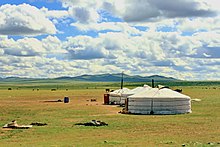
Trade habits[edit]
The major centers of population and high culture in Eurasia are Europe, the Middle East, India and China. For some purposes it is useful to treatGreater Iranas a separate region. All these regions are connected directly or indirectly by the EurasianSteppe routewhich was an active predecessor of theSilk Road.The latter started in theGuanzhongregion of China and ran west along the Hexi Corridor to the Tarim Basin. From there it went southwest to Greater Iran and turned southeast to India or west to the Middle East and Europe. A minor branch went northwest along the great rivers and north of the Caspian Sea to the Black Sea. When faced with a rich caravan thesteppe nomadscould either rob it, or tax it, or hire themselves out as guards. Economically, these three forms of taxation or parasitism amounted to the same thing. Trade was usually most vigorous when a strong empire controlled the steppe and reduced the number of petty chieftains preying on trade. The silk road first became significant and Chinese silk began reaching the Roman Empire about the time that theEmperor of Hanpushed Chinese power west to the Tarim Basin.
Agriculture[edit]

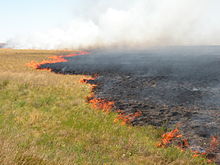
The nomads would occasionally tolerate colonies of peasants on the steppe in the few areas where farming was possible. These were often captives who grew grain for their nomadic masters. Along the fringes there were areas that could be used for either plowland or grassland. These alternated between one and the other depending on the relative strength of the nomadic and agrarian heartlands. Over the last few hundred years, the Russian steppe and much of Inner Mongolia has been cultivated. The fact that most of the Russian steppe is not irrigated implies that it was maintained as grasslands as a result of the military strength of the nomads.
Language[edit]
According to the most widely held hypothesis of the origin of theIndo-European languages,theKurgan hypothesis,their common ancestor is thought to have originated on the Pontic-Caspian steppe. TheTocharianswere an early Indo-European branch in theTarim Basin.At the beginning of written history the entire steppe population west of Dzungaria spokeIranian languages.From about 500 AD theTurkic languagesreplaced theIranian languagesfirst on the steppe, and later in the oases north ofIran.Additionally,Hungarianspeakers, a branch of theUraliclanguage family, who previously lived in the steppe in what is now Southern Russia, settled in theCarpathian basinin year 895.Mongolic languagesare in Mongolia. In Manchuria one findsTungusic languagesand some others.
Religion[edit]
Tengrismwas introduced byTurko-Mongolnomads.NestorianismandManichaeismspread to the Tarim Basin and into China, but they never became established majority religions.Buddhismspread from the east of India to the Tarim Basin and found a new home in China. By about 1400 AD, the entire steppe west ofDzungariahad adoptedIslam.[citation needed]By about 1600 AD,Islamwas established in the Tarim Basin while Dzungaria and Mongolia had adoptedTibetan Buddhism.
History[edit]
This sectionpossibly containsoriginal research.(September 2014) |
Warfare[edit]
Raidsbetween tribes were prevalent throughout the region's history.[citation needed]This relates to the ease with which a defeated enemy's flocks and herds can be driven away, making raiding profitable. In terms of warfare and raiding, in relation to sedentary societies, the horse gave the nomads an advantage of mobility. Horsemen could raid a village and retreat with their loot before aninfantry-based army could be mustered and deployed. When confronted with superior infantry, horsemen could simply ride away, retreat and regroup. Outside of Europe and parts of the Middle East, agrarian societies had difficulty raising a sufficient supply ofwar horsesand often had to enlist cavalry from their nomadic enemies (asmercenaries). Nomads could not easily be pursued onto the steppe[clarification needed]since the steppe could not easily support a land army. If the Chinese sent an army into Mongolia, thenomadswould flee and come back when the Chinese ran out of supplies. But the steppe nomads were relatively few and their rulers had difficulty holding together enough clans and tribes to field a large army. If steppe nomads conquered an agricultural area they often lacked the skills to administer it. If they tried to hold agrarian land they gradually absorbed the civilization of their subjects, lost their nomadic skills and were either assimilated or driven out.[citation needed]
Relations with neighbors[edit]
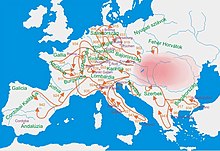
Along the northern fringe of the Eurasian steppe, nomads would collect tribute from and blend with the forest tribes (seeKhanate of Sibir,Buryats).[citation needed]Russia paidtribute(compareyasak) to theGolden Horde[18] from about 1240 to 1480.[19] South of the Kazakh steppe the nomads blended with the sedentary population, partly because the Middle East has significant areas of steppe (taken by force in past invasions) and pastoralism. There was a sharp cultural divide between Mongolia and China and almost constant warfare from the dawn of history until theQing conquest of Dzungariain 1757.[citation needed]The nomads collected large amounts of tribute from the Chinese and several Chinese dynasties were of steppe origin. Perhaps because of the mixture of agriculture and pastoralism in Manchuria its inhabitants, theManchuknew how to deal with both nomads and the settled populations and therefore were able to conquer much of northern China[when?]when both Chinese and Mongols were weak.[original research?]
Legacy of the Eurasian steppe's nomads[edit]
The steppe culture of Russia was shaped in Russia through cross-cultural contact mostly by Slavic, Tatar-Turkic, Mongolian and Iranian people.[20][21][need quotation to verify]Rus'rulers would ally themselves by marriage with fellow-steppe peoples.[22] In addition to ethnicity, also instruments such as thedomra,[23]traditional costumes such as thekaftan.RussianCossackandtea culturewere strongly influenced by the culture of Asian nomadic peoples.[24]The Eurasian steppes play a major role in Eastern Europe history and the steppes are a subject of many Slavic as well as Russianfolk-songs.[25][26][27]
Historical peoples and nations[edit]
- Thracians15th-3rd centuries BC
- Chorasmia13th–3rd centuries BC
- Cimmerians12th–7th centuries BC
- Magyars11th century BC – 8th century AD
- Scythians8th–4th centuries BC
- Sogdiana8th–4th centuries BC
- Issedones7th–1st century BC
- Massagetae7th–1st century BC
- Thyssagetae7th–3rd century BC
- Donghu7th – 2nd century BC
- Dahae7th BC-5th century AD
- Saka6th–1st centuries BC
- Sarmatians5th century BC – 5th century AD
- Bulgars7th century BC–7th century AD[28]
- Transoxiana4th century BC – 14th century AD
- Xiongnu3rd century BC – 2nd century AD
- Iazyges3rd century BC – 5th century AD
- Yuezhi2nd century BC – 1st century AD
- Tauri
- Wusun1st century BC – 6th century AD
- Xianbei1st–3rd centuries
- Goths3rd–6th centuries
- Vandals2nd–5th centuries
- Visigoths3rd–5th centuries
- Franks3rd–8th centuries
- Huns4th–8th centuries
- Ostrogoths4th–8th centuries
- Early Slavs5th-10th centuries
- Alans5th–11th centuries
- Avars5th–9th centuries
- Hepthalites5th–7th centuries
- Eurasian Avars6th–8th centuries
- Göktürks6th–8th centuries
- Sabirs6th–8th centuries
- Khazars7th–11th centuries
- Onogurs8th century
- Pechenegs8th–11th centuries
- Bashkirs10th century-present day
- KipchaksandCumans11th–13th centuries
- Crimean Goths
- Mongol Empire13th–14th centuries
- Chagatai Khanate13th–15th centuries
- Golden Horde13th–15th centuries
- Kazakh Khanate15th–19th centuries
- Cossacks,Kalmyks,Crimean Khanate,Volga Tatars,Nogaisand otherTurkicstates and tribes 15th–18th centuries
- Russian Empire16th–20th centuries
- Soviet Union20th century
- Gagauzia,Kazakhstan,Russian Federation,Ukraine,Xinjiang20th–21st centuries
See also[edit]
References[edit]
- ^Scott, Geoffrey A. J. (1995-01-10).Canada's vegetation: a world perspective – Geoffrey A. J. Scott – Google Knihy.McGill-Queen's Press - MQUP.ISBN9780773565098.Archivedfrom the original on 2013-10-29.Retrieved2012-02-09.
- ^King, S.R.B.; Boyd, L.; Zimmermann, W. & Kendall, B.E. (2016) [errata version of 2015 assessment]."Equus ferusssp.przewalskii".IUCN Red List of Threatened Species.2015:e.T7961A97205530.doi:10.2305/IUCN.UK.2015-2.RLTS.T7961A45172099.en.Retrieved29 October2018.
- ^IUCN SSC Antelope Specialist Group (2023)."Saiga tatarica".IUCN Red List of Threatened Species.2023:e.T19832A233712210.doi:10.2305/IUCN.UK.2023-1.RLTS.T19832A233712210.en.Retrieved29 December2023.
- ^IUCN SSC Antelope Specialist Group (2017) [errata version of 2016 assessment]."Procapra gutturosa".IUCN Red List of Threatened Species.2016:e.T18232A115142812.doi:10.2305/IUCN.UK.2016-3.RLTS.T18232A50193126.en.Retrieved29 December2023.
- ^IUCN SSC Antelope Specialist Group (2017)."Gazella subgutturosa".IUCN Red List of Threatened Species.2017:e.T8976A50187422.doi:10.2305/IUCN.UK.2017-2.RLTS.T8976A50187422.en.Retrieved11 November2021.
- ^Hare, J. (2008)."Camelus ferus".IUCN Red List of Threatened Species.2008:e.T63543A12689285.doi:10.2305/IUCN.UK.2008.RLTS.T63543A12689285.en.Retrieved11 November2021.
- ^Kaczensky, P.; Lkhagvasuren, B.; Pereladova, O.; Hemami, M.; Bouskila, A. (2020)."Equus hemionus".IUCN Red List of Threatened Species.2020:e.T7951A166520460.doi:10.2305/IUCN.UK.2020-1.RLTS.T7951A166520460.en.Retrieved11 November2021.
- ^Boitani, L.; Phillips, M.; Jhala, Y. (2023) [amended version of 2018 assessment]."Canis lupus".IUCN Red List of Threatened Species.2023:e.T3746A247624660.doi:10.2305/IUCN.UK.2023-1.RLTS.T3746A247624660.en.Retrieved29 December2023.
- ^Murdoch, J.D. (2014)."Vulpes corsac".IUCN Red List of Threatened Species.2014:e.T23051A59049446.doi:10.2305/IUCN.UK.2014-2.RLTS.T23051A59049446.en.Retrieved11 November2021.
- ^Gutleb, Bernhard; Ziaie, Hooshang (1999). "On the distribution and status of the Brown Bear,Ursus arctos, and the Asiatic Black Bear,U. thibetanus,in Iran ".Zoology in the Middle East.18:5–8.doi:10.1080/09397140.1999.10637777.
- ^Lorestani, Niloufar; Hemami, Mahmoud-Reza; Rezvani, Azita; Ahmadi, Mohsen (December 2022)."Ecological niche models reveal divergent habitat use of Pallas's cat in the Eurasian cold steppes".Ecology and Evolution.12(12): 3.Bibcode:2022EcoEv..12E9624L.doi:10.1002/ece3.9624.PMC9750817.PMID36532134.Retrieved27 March2024.
- ^Batsaikhan, N.; Tsytsulina, K. (2017) [errata version of 2016 assessment]."Meriones unguiculatus".IUCN Red List of Threatened Species.2016:e.T13171A115110851.doi:10.2305/IUCN.UK.2016-3.RLTS.T13171A22432999.en.Retrieved29 December2023.
- ^Cassola, F. (2017)."Spermophilus pygmaeus".IUCN Red List of Threatened Species.2017:e.T20490A22264478.doi:10.2305/IUCN.UK.2017-2.RLTS.T20490A22264478.en.Retrieved11 November2021.
- ^Tsytsulina, K.; Zagorodnyuk, I.; Formozov, N.; Sheftel, B. (2017) [errata version of 2016 assessment]."Marmota bobak".IUCN Red List of Threatened Species.2016:e.T12830A115106780.doi:10.2305/IUCN.UK.2016-3.RLTS.T12830A22258375.en.Retrieved29 December2023.
- ^"Archived copy"(PDF).Archived(PDF)from the original on 2017-08-08.Retrieved2017-05-26.
{{cite web}}:CS1 maint: archived copy as title (link) - ^Tu, Ya; Yao, Zhenyu; Guo, Jianying; Yang, Liu; Zhu, Yuanjun; Yang, Xiaohui; Shi, Zhongjie; Indree, Tuvshintogtokh (June 2024)."Predicting the potential risk of Caragana shrub encroachment in the Eurasian steppe under anthropogenic climate change".Science of the Total Environment.944:173925.Bibcode:2024ScTEn.94473925T.doi:10.1016/j.scitotenv.2024.173925.PMID38866162.
- ^Természettudományi Múzeum (Hungary) (1969).Annales historico-naturales Musei Nationalis Hungarici.
- ^
Halperin, Charles J. (1985). "Economic and Demographic Consequences".Russia and the Golden Horde: The Mongol Impact on Medieval Russian History.History Russian studies. Bloomington: Indiana University Press (published 1987). p. 78.ISBN9780253204455.Retrieved17 May2021.
The Russian peasantry felt the Tatars' economic oppression much more than the Russian aristocracy and indeed the Russian princes profited from the exploitation of their people. The grand princes were in charge of collecting tribute for the Mongols, and this proved so profitable that the throne was more than worth the large bribes the khan required before awarding it.
- ^
Uspensky, Gleb (1993).The Insider's Guide to Russia.Insiders' Guide Travel Series. Hunter Publishing. p. 44.ISBN9781556505584.Retrieved17 May2021.
[...] Russia [...] in 1480, stopped paying tribute to the now-shaky and fragmented Golden Horde.
- ^Neumann, Iver B. (2018-07-19).The steppe tradition in international relations: Russians, Turks and European state-building 4000 BCE-2018 CE.Wigen, Einar, 1981- (First ed.). Cambridge, United Kingdom. pp. 198–250.ISBN9781108420792.OCLC1053859731.
{{cite book}}:CS1 maint: location missing publisher (link) - ^Blench, Roger; Spriggs, Matthew (2003-09-02).Archaeology and Language I: Theoretical and Methodological Orientations.Routledge.ISBN9781134828777.
- ^
Histoire Russe.University Center for International Studies, University of Pittsburgh. 1992. p. 11.Retrieved17 May2021.
The marriages of Rus' princes to the daughters of thePolovtsykhans [...].
- ^Sultanova, Razia; Rancier, Megan (2018-01-19).Turkic Soundscapes: From Shamanic Voices to Hip-Hop.Routledge.ISBN9781351665957.
- ^Hellie, Richard. (1999).The economy and material culture of Russia, 1600-1725.Chicago: University of Chicago Press. pp. 352–353.ISBN0226326497.OCLC39655294.
- ^Алексей Мочалов ღ романса трепетные звуки (2013-12-18),Степь да степь кругом /русская народная песня/ Russian folk song/ Steppe all around,archivedfrom the original on 2021-12-13,retrieved2019-06-11
- ^NIK KIRIN (2013-04-08),"Ах ты, степь широкая".[HD].,archived fromthe originalon 2014-11-04,retrieved2019-06-11
- ^Олег Семёнов (2019-03-30)."Пелагея и Кубанский казачий хор – Любо, братцы, любо! (2019 HD)".YouTube.Archivedfrom the original on 2021-12-13.Retrieved2019-06-11.
- ^"The Proto-Turkic Urheimat and the Early Migrations of Turkic Peoples".Archived fromthe originalon December 24, 2013.RetrievedApril 20,2014.
Bibliography[edit]
- Barthold, W. (1992).Turkestan Down to the Mongol Invasion.Translated by Minorsky, T. New Delhi: Munshiram Manoharlal Publishers.
- Christian, David (1998).A History of Russia, Central Asia and Mongolia.Vol. 1: Inner Eurasia from Prehistory to the Mongol Empire. Blackwell Publishing.
- Fletcher, Joseph F. (1995). "The Mongols: ecological and social perspectives". In Forbes Manz, Beatrice (ed.).Studies on Chinese and Islamic Inner Asia.Aldershot, Hampshire: Variorum.
- Grousset, René(1970).The Empire of the Steppes: A History of Central Asia.Translated by Walford, Naomi. New Brunswick, NJ:Rutgers University Press.
- John of Plano Carpini (2005). "History of the Mongols". In Dawson, Christopher (ed.).Mission to Asia.Toronto: University of Toronto Press. pp. 3–76.
- Krader, Lawrence (1955). "Ecology of Central Asian Pastoralism".Southwestern Journal of Anthropology.11(4): 301–326.doi:10.1086/soutjanth.11.4.3628907.S2CID130062187.
- Lattimore, Owen(1962). "The Geographical Factor in Mongol History". In Lattimore, Owen (ed.).Studies in Frontier History: Collected Papers 1928–1958.London: Oxford University Press. pp. 241–258.
- Sinor, Denis(1997). "The Inner Asian Warrior". In Sinor, Denis (ed.).Studies in Medieval Inner Asia.Collected Studies Series. Aldershot, Hampshire: Ashgate.ISBN978-0-86078-632-0.
- Sinor, Denis (1977). "Horse and Pasture in Inner Asian History". In Sinor, Denis (ed.).Inner Asia and its Contacts with Medieval Europe.Collected Studies Series. London: Variorum.
External links[edit]
- "The importance of the Eurasian steppe to the study of international relations"inJournal of International Relations and Development
- Eurasian Steppe
- Central Asia
- East Asia
- Eastern Europe
- Ecoregions of Asia
- Ecoregions of Europe
- Eurasia
- Geography of Central Asia
- Geography of East Asia
- Geography of Europe
- Geography of Siberia
- Grasslands of Asia
- Grasslands of Europe
- Grasslands of Russia
- Social history of India
- Southern Europe
- Temperate grasslands, savannas, and shrublands
- Western Europe













